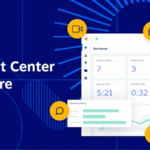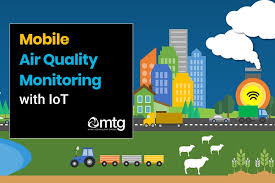We often take the air we breathe for granted. It’s invisible, so it’s easy to ignore. But the truth is, the quality of our air is directly tied to our health, comfort, and long-term sustainability. In the UK, where urbanisation is expanding fast, air pollution has become a quiet but serious issue. From asthma in children to cardiovascular problems in the elderly, the effects are very real.
Thankfully, tech has stepped in. And at the heart of this digital transformation is the mobile app development company in the UK that’s rethinking how we monitor and respond to air quality. With a mix of IoT sensors, mobile apps, and cloud-based platforms, software development companies are now creating smart air quality monitoring networks that are more responsive, precise, and publicly accessible than ever.
What Are Air Quality Monitoring Networks?
Air quality monitoring networks are systems made up of various sensors placed across different locations—cities, neighbourhoods, schools, even homes. These sensors collect data on pollutants like:
-
Nitrogen dioxide (NO₂)
-
Particulate matter (PM2.5 and PM10)
-
Ozone (O₃)
-
Carbon monoxide (CO)
The data is then processed, analyzed, and sent to cloud servers. From there, apps and dashboards display this information in real-time.
From Government to Citizen
Traditionally, monitoring was done by government agencies using large, expensive stations. These stations are accurate but too few in number. A new generation of software development companies is solving this by developing networks with smaller, cheaper sensors, connected via mobile apps. And the good news? Anyone can access this data right from their phone.
The Role of a Mobile App Development Company in the UK
Real-Time Accessibility for All
One of the main achievements by any leading mobile app development company in the UK is building mobile-first experiences. For air quality monitoring, this means intuitive apps where users can see:
-
Live air quality updates
-
Alerts for unhealthy conditions
-
Long-term exposure reports
-
Advice based on age, health conditions, and location
For instance, if you’re jogging in Hyde Park, the app can notify you if it’s a good time to run or if pollution levels are high. That kind of personalized data was unthinkable a decade ago.
Backend Brilliance
While users see a simple app, the magic happens in the backend. The app talks to APIs that collect data from multiple IoT devices, then use cloud services to process and visualize this data in real-time.
These systems often include:
-
Geo-fencing for location-specific alerts
-
Machine learning to predict pollution spikes
-
Data aggregation from third-party environmental APIs
-
Historical data archiving
All this is managed by the software development companies who ensure the infrastructure is fast, scalable, and secure.
Who’s Using These Apps?
1. Local Councils and City Planners
They use dashboards powered by these apps to make decisions about:
-
Road closures
-
Traffic redirection
-
Urban green space planning
-
Construction permits
2. Environmental NGOs and Activists
They rely on granular data to raise awareness, run campaigns, and challenge policy.
3. Ordinary Citizens
Families with children, people with asthma, cyclists, joggers—they all benefit from real-time updates that help them plan better and stay safe.
Features That Make These Apps Stand Out
Custom Notifications Based on Health Profiles
Users can input health data (e.g. asthma, age, allergies), and the app adjusts alerts accordingly.
Visual Maps with Colour-Coded Zones
Red for danger, green for go. Simple visual cues let people instantly understand what areas are safer.
Pollution Heatmaps and Trend Graphs
These let you track how your local air quality changes over days, weeks, or months.
Integration with Wearables
Some of the more advanced apps now sync with Apple Watch or Fitbit, giving pollution exposure warnings during outdoor workouts.
Community Reports and Feedback
Users can report burning garbage, excessive traffic fumes, or industrial emissions directly within the app—helping authorities and communities take quick action.
Why UK Is Leading in This Tech
The UK government has placed clean air at the centre of its environmental policy. Major cities like London, Manchester, and Birmingham already use air quality dashboards for public planning. As a result, demand has surged for innovative solutions.
This is where a mobile app development company in the UK truly shines—local understanding combined with global-level tech skills. These companies know the UK’s air quality challenges and regulatory landscape inside out, enabling them to build apps that are not only functional but also fully compliant with DEFRA (Department for Environment, Food & Rural Affairs) standards.
Case Studies of Innovation
Project CleanSky – London
Developed by a mobile app development company in the UK, this app connects with over 200 sensors across London. It helped reduce peak pollution exposure among schoolchildren by 30% by sending timely alerts to parents and educators.
BreatheWell – Birmingham
A collaboration between local health authorities and software development companies, BreatheWell personalizes data for patients with respiratory conditions. It even suggests alternative routes when pollution is high, ensuring safer commutes.
EcoGuard – Manchester
Built with gamification elements, EcoGuard lets citizens earn rewards for reporting pollution violations. This crowd-sourced model led to over 5,000 reports in the first 3 months—proving the power of app-based civic engagement.
Technologies Used by Software Development Companies
To build and maintain these networks, software development companies employ a wide range of cutting-edge tech:
-
IoT (Internet of Things): For collecting environmental data using low-energy sensors
-
5G Networks: For transmitting large volumes of data quickly and reliably
-
Edge Computing: For processing data near the source, reducing latency
-
Cloud Platforms: Like AWS and Azure for storage and analytics
-
AI/ML Algorithms: For forecasting pollution levels and spotting anomalies
-
GIS Integration: For spatial mapping and navigation assistance
And most importantly, the mobile apps are designed with user-centric UI/UX principles, ensuring even the least tech-savvy users can interact with the data.
Challenges in Building These Networks
Data Accuracy and Calibration
Cheaper sensors often face calibration issues. Companies must invest in smart algorithms to cross-validate and clean data in real-time.
Battery Life and Maintenance
Outdoor sensors need to run for months without manual intervention. Solar charging and low-power processors are used to overcome this.
Data Privacy
Some apps track your location continuously to give alerts. This raises concerns about privacy, which is why strict GDPR compliance is crucial—something software development companies in the UK are well-versed in.
Scalability
As more users join the platform and more sensors are deployed, the backend must handle increasing loads without crashing or slowing down. Using microservices and containerization helps with scaling effectively.
The Business Opportunity for App Developers
There’s a growing market for sustainability-focused tech, and air quality apps are at the centre of it. Municipalities, healthcare institutions, environmental organisations, and even large retailers are interested in this data.
This presents a huge opportunity for any mobile app development company in the UK that wants to specialize in:
-
GreenTech and ClimateTech verticals
-
Smart City Solutions
-
Citizen Engagement Platforms
Moreover, offering air quality monitoring as part of broader smart city packages can open up international projects and partnerships.
What the Future Looks Like
Indoor Air Quality Will Take the Spotlight
Post-COVID, indoor air quality is just as important as outdoor. Apps will soon monitor air in offices, schools, and malls in real-time.
Hyperlocal Monitoring
Instead of city-wide averages, users will want street-level accuracy—something only advanced sensor networks and smart app integration can deliver.
AI-Powered Personal Recommendations
Apps will eventually tell users, “Wait 20 minutes before leaving; air quality will improve,” or “Take an umbrella and your mask—high pollution alert.”
Final Thoughts
The fight for clean air isn’t just about policies and protests. It’s also about pixels and code. Thanks to the brilliant minds at every mobile app development company in the UK, we now have tools that empower us to understand and act on air pollution in ways we never imagined before.
Whether you’re a parent, a policymaker, or a jogger in the park, these apps let you make smarter choices for your health. And that’s what good technology does—it makes life better, one breath at a time.
- Air Quality Monitoring Apps by a Mobile App Development Company in the UK
- Discover how a mobile app development company in the UK is building smart air quality monitoring networks. Learn how software development companies are helping cities fight pollution with real-time apps and IoT tech.
- Mobile App Development Company in the UK
Related posts:
 Used Mobile in Dubai: Your Ultimate Guide to Buying Quality Phones at Affordable Prices
Used Mobile in Dubai: Your Ultimate Guide to Buying Quality Phones at Affordable Prices
 How a Mobile App Development Company in India Drives Innovation for Your Business
How a Mobile App Development Company in India Drives Innovation for Your Business
 Branded SMS Marketing in Karachi: Reach Customers with a Personal Touch
Branded SMS Marketing in Karachi: Reach Customers with a Personal Touch
 Managing High-Volume Sales Season Calls in E-commerce with Cloud Contact Centre Software
Managing High-Volume Sales Season Calls in E-commerce with Cloud Contact Centre Software
 iPhone 13 Pro Max vs iPhone 13: Key Differences You Should Know Before Buying
iPhone 13 Pro Max vs iPhone 13: Key Differences You Should Know Before Buying
 Textlocal Shutdown?: Here Are the Top SMS Platforms to Try in 2025
Textlocal Shutdown?: Here Are the Top SMS Platforms to Try in 2025
 Top 10 Expert Tips to Sell Phone Fast and Without the Stress
Top 10 Expert Tips to Sell Phone Fast and Without the Stress
 Experience Speed with iQOO Z10x 5G: Full Specifications & Benefits for Speed Lovers
Experience Speed with iQOO Z10x 5G: Full Specifications & Benefits for Speed Lovers







